2011 Thunderous Prime
This video is a great presentation of all the features of Thunderous Prime, 1511's 2011 robot. All animations, video, and slides prepared by me, narration by me.
2010 - Thunderfoot
This year's robot was designed to play a game similar to soccer, with a large kicker foot to punt soccer balls across the field. It also had a hanging mechanism that allowed it to lift itself onto the field's tower at the end of the match for bonus points.
Hanger
I coded the hanger to automatically ramp the speed of the lift up and down, based on its current position in the lift, using a chunk of a sine wave and a PID loop. This speed ramping was crucial to getting our robot up fast enough to score points at the end of a match, but also making the lift smooth so the robot did not slide down the pole.
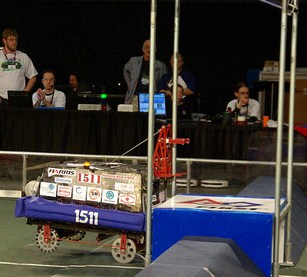
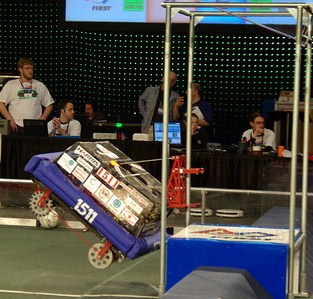
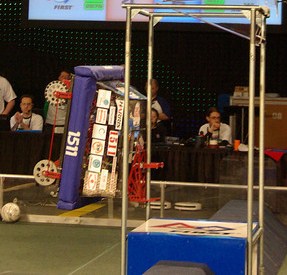
Kicker
The kicker mechanism comes in two parts. The actual kicker foot freely spins around an axis and is pulled forward with surgical tubing (like a giant rubber band), and the "yoke" moves with the foot to pull it back and let it go. The yoke has two electromagnets to hold onto the kicker, and is powered by two motors to move it. My code coordinated the motors to automatically move the yoke to different positions (for more or less powerful kicks) and turned the electromagnets on and off to hold the kicker or allow it to kick. The code also prevented the kicker from firing more than once within two seconds (which would result in a penalty), and automatically retrieved the kicker once it had fired and pulled it back again. The person running the kicker simply had to tell it the power they wanted and push the fire button.
(This is a prototype of our robot, the finished version works much faster)
2009 - Thunderplucker
Thunderplucker was designed to play a game called "Lunacy." In that game, robots had to pick up balls called moon rocks, which were made of interwoven plastic strips, and score them into trailers that were pulled by the opposing alliance's robots. Robots also had to keep opponents from scoring in their trailers, so scoring fast and getting out of the way was crucial to not giving points away.
Belt system and Shooter
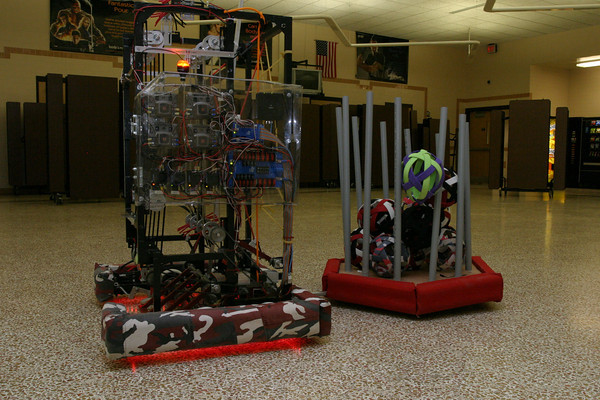

I coded the upper mechanism of this robot, which consists of three main parts. There are two belts that run up and down the robot - one in front and one in the center - which move the balls from the bottom to the shooter at the top. Depending on which way the shooter is spinning, balls are either placed in the back of the robot for storage, or shot out the front. There is also a gate at the bottom of the robot that determines whether the shooter is being fed from the floor or from storage. For the controls, all of these parts were put into groups, so that the driver simply had to push the fire button and the gate, belts, and shooter would move in order to allow firing. Additional code was put in later to allow the top shooter to maintain a constant speed no matter how many balls were being fired (in essence, cruise control), which added greater distance to our shots.
2008 - Mach 1511
Mach 1511 was designed to drive as fast as possible around a track on the field. Additionally, it could smack huge balls off of the overpasses that went across the middle of the track, and then go pick them up and throw them over the overpasses or put them back on top again.
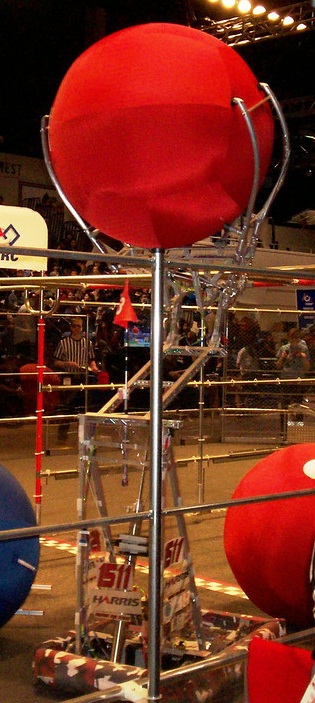
Electrical board
I was on the electrical subteam and worked on the electrical boards, which involved running wires to various motors, speed controllers, and sensors, as well as making sure those wires were out of the way of any moving parts. We had to minimize wire length and figure out what kind of control boards were the most weight- and cost-effective for the motors on the robot, and we had to make sure absolutely everything was behind a circuit breaker so it wouldn't fry. We also ran the tubes for the pneumatics on the robot.